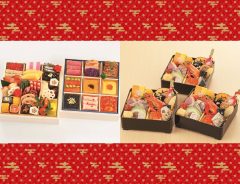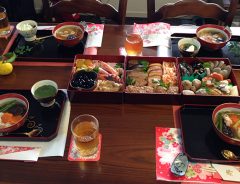
Source: CC BY-SA 3.0
Centenarian ladies explain the lifetime of experiences that go into Osechi cuisine
- Tags:
- centenarian / Osechi / osechi cuisine
Related Article
-

Japanese confectioners promise sweet version of osechi ryori with their New Year cake set
-

Historic Kyoto tea house Itokyuemon releases special New Year’s traditional sweets
-

Organize A New Year’s Party in Japan And Feed 30 People With This Gargantuan Osechi Platter
-

2021 New Year’s Osechi pre-orders begin, revealing pandemic-adapted offerings
-

Enjoy the New Year with the whole family with this dog friendly Osechi-ryōri
-

Learn How To Prepare Osechi New Year’s Dishes At Japanese Cooking School For Foreigners


When you think of Japan, the first things that often come to mind are overcrowded Tokyo wards and neon shopping districts set abuzz. During non-pandemic times, Tokyo attracts some 13 or 14 million visitors a year, and the mega city continues to increase in population, almost to the point of breaking. Osaka, the largest city in the Kansai region, is no different. In recent years, the 2nd largest economic center in Japan has peaked at about 19 million residents.
At grape Japan, we’ve touched on rural flight before. Certainly not unique to Japan, the phenomenon is creating resource-vacuums across disparate countryside communities. As young people feel compelled to search for employment in major cities, stationary elderly members are witnessing temple closings and petrol shortages.
Indeed, it appears all roads lead to Tokyo. Nevertheless, it begs the question of whether something is lost with a fast-pace, metropolitan life. I've spent some time living in the mountains and can certainly understand why some stress the importance of slowing down. Life feels a little different at a relaxed pace as the hustle and bustle and busier concerns fall away.
New Year’s Customs: Oshōgatsu and Osechi
In Japan, Oshōgatsu 正月, the Japanese New Year, is by far the most important holiday. Residents take time off work and engage in ceremonial acts over the three-day celebration. For many families, this often involves a trip to Grandma's house, which is more likely than not in a remoter area of the country.
Osechi-ryōri 御節料理, New Year’s food, is a mainstay of the celebration. Served in elegant jūbako 重箱, square dishes for serving food, the meal is typically comprised of rice cake, seafood, vegetables, and pickles. Certain items like shrimp or red sea-bream are also quintessential and have a kind of superstitious significance. As a major banquet, traditional Osechi-ryōri involves painstaking planning and preparation that may spread over as long as a month.
The Osechi series: Masami from Nagano
On their YouTube channel, Grandma's Recipes follows several older women as they prepare homegrown Osechi meals. The series focuses on "eccentric, lovely but 'Rock' ladies above the age of 80, who have lived through World War Two." The channel hopes to share their stories with younger people to celebrate their depth of life, and to "appreciate the dinner table just a little bit more."
Masami is one of many Japanese centenarians, who began a working life from the age of eight. From a young age, she left her family to become a live-in nanny. As such, she was partly raised by other people. Like many from her generation, Masami was poor growing up and couldn’t enjoy elaborate Osechi during the holidays, only rice cake and rabbit meat.
Throughout the video, the farmer makes pickled vegetables and koikoku 鯉こく, a boiled carp dish made with tea and vegetables. The recipe is simple but is boiled for three days before being served with miso. For young Masami, a whole fish comprised a feast, and the dish could last for over two weeks.
Masami also recalls her family. She had five children but lost one shortly after birth. She raised them with her husband, who she wed in an arranged marriage. Arranged marriages were common in Japan throughout history. Masami left the man she was seeing and married the person her parents told her to.
Sumiko from Kochi
Sumiko lives on a farm it seems she inherited from her family. A long time ago, they built a wall to produce the plot of land that she continues to farm to this day.
Throughout the video, she works to make Sawachi-ryōri, a set of regional dishes consisting of sushi, sweet bean paste, kelp, and fish paste, among other things. Her favorite bit is easily mackerel sushi. For this, the mackerel is salted and placed in yuzu vinegar to give it a sour taste.
Japanese spirituality largely stems from Shintoism, an East Asian indigenous religion, and Buddhism. As such, these traditions affect New Year's customs. Sumiko's family appears to be Shintoist. During the end-of-year and new-year period, she is very busy with temple visits, prayers, and other ceremonial acts, all for the sake prosperous year.
Saeko from Gifu
This video begins with Saeko going more in-depth about Japanese spirituality. She explains that Shintoism and Buddhism were historically intertwined; however, they were officially separated in the Meiji period when Shinto became the national religion of Japan. Saeko lives at the center of this interplay. She was born to a Buddhist household but became a Shintoist upon marrying.
Saeko takes a moment to explain her Osechi preparations. She begins the process early around December 10th, preparing sushi and pickled shredded daikon. She uses a lot of rice malt in making her sushi. This gives the fish a sweet taste that keeps throughout the festivities.
Finally, she explains the importance of New Years's customs. She was taught by her mother-in-law religious acts that have been passed along generations. Throughout, Saeko offers prescribed dishes to the household alter of her ancestors. Her family also places a special Kadomatsu tree at the entranceway to her property. The tree helps bring in a prosperous New Year. Like other homemakers, she is very busy throughout the season.